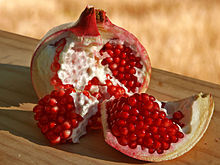I am writing a series of 101 small changes that we can make to make the quality of our life better and build and lead a happier life that is in tune with our heart and mind. These are small changes that I have made and am working on now, so I know they are possible for anyone to do.
If you have not read previous posts, check out a few posts on the changes from the past:
101 changes: Change 13: Reduce Eating Fast Food
————————————————————————————————————-

Pomegranate fruit or its juice is popular in India and other part of Asia. In US, many people seem to know and drink POM juice bottles, which seems to be popular among some health conscious people. However, fresh Pomegranate fruits are easily available in even regular store and can be used in variety ways in cooking for its nutrition. One of my friend wanted to try eating fresh fruit but did not know how to cut and use in recipes or even making a juice at home. While cutting open Pomegranate fruit is not complicated, it can be messy and its juice can stain your clothes and sometimes even counter top. So, taking some minor precautions will make this task much simpler and easier.
About Pomegranate Fruit:
Pomegranate fruit is native to Iran and used in Asian areas such as northern India and Himalayas region. It is now cultivated in California and Arizona area. There are several varieties of Pomegranate with flowers and without fruit which are grown for its red flowers looks. Usually fruit is size of large lemon or grapefruit size. One fruit can hold anywhere from 300 to 1500 seeds, depending on size.

Health Benefits of Pomegranate:
- Used in Aryuvedic medicine for traditional remedy against diarrhea, dysentery and intestinal parasites.
- Its juice is used in Aryuvedic medicine for stopping nose bleeding and gum bleeding.
- It is also used for firming-up sagging breasts and treating hemorrhoids
- Some use the juice as eye drops for cataracts
- It supposed to help reduce the heart disease risks
- It provides Vitamic C, B5, Potassium and other flavonoids
- Pomegranate is high in fiber which is best for digestion
Where and how Pomegranate can be used in cooking?
Pomegranate juice and seeds both can be used in various ways in savory or sweet recipe dishes. Juice can be drank, reduced to make syrup as gravy on top. Seeds can be used in salad, chutney, curry sauce, as a garnish on soup and stews. Dried Pomegranate seeds can be used in dry cereal or making granola bars, topping on yogurt, frozen yogurt and so on.

How to Open or Peel Pomegranate fruit?
- I usually cut the small crown on top of the fruit first to make it easier.
- Score Pomegranate in four quarters with sharp knife, do not worry about breaking the seeds.
- Put all four pieces in bowl filled with cool water, one at the time.
- Softly take out seeds by gentle hand touch to dislodge seeds from the cut pieces.
- Once out seeds should sink and other fruit part will float.
- Take out the floating parts and drain the water and take out seeds.
- Place wet pomegranate seeds on to paper towel to pat dry
- Now it can be used to be eaten raw or in any recipes as you desire.
- You can keep those fresh pomegranate seeds in fridge for 4-5 days.
- Add to Salad, juice can be added in to dressing, garnish on yogurt, soup, stew, pasta, couscous or in vegetables.
For those of us who are busy can buy frozen Pomegranate seeds or dried Pomegranate seeds delivered to your home, or ask skilled friend or mom to do it for you. I like those fresh Pomegranate seeds, it looks so much like small bright ruby stone that you can eat and are cheaper than real ruby gems!
Disclaimer: I am not a doctor and so always check with your doctor and its facts before trying out at your own judgement and risk.
Salad Image source: http://www.realepicurean.com
Other Image source: Wikipedia, imgfave